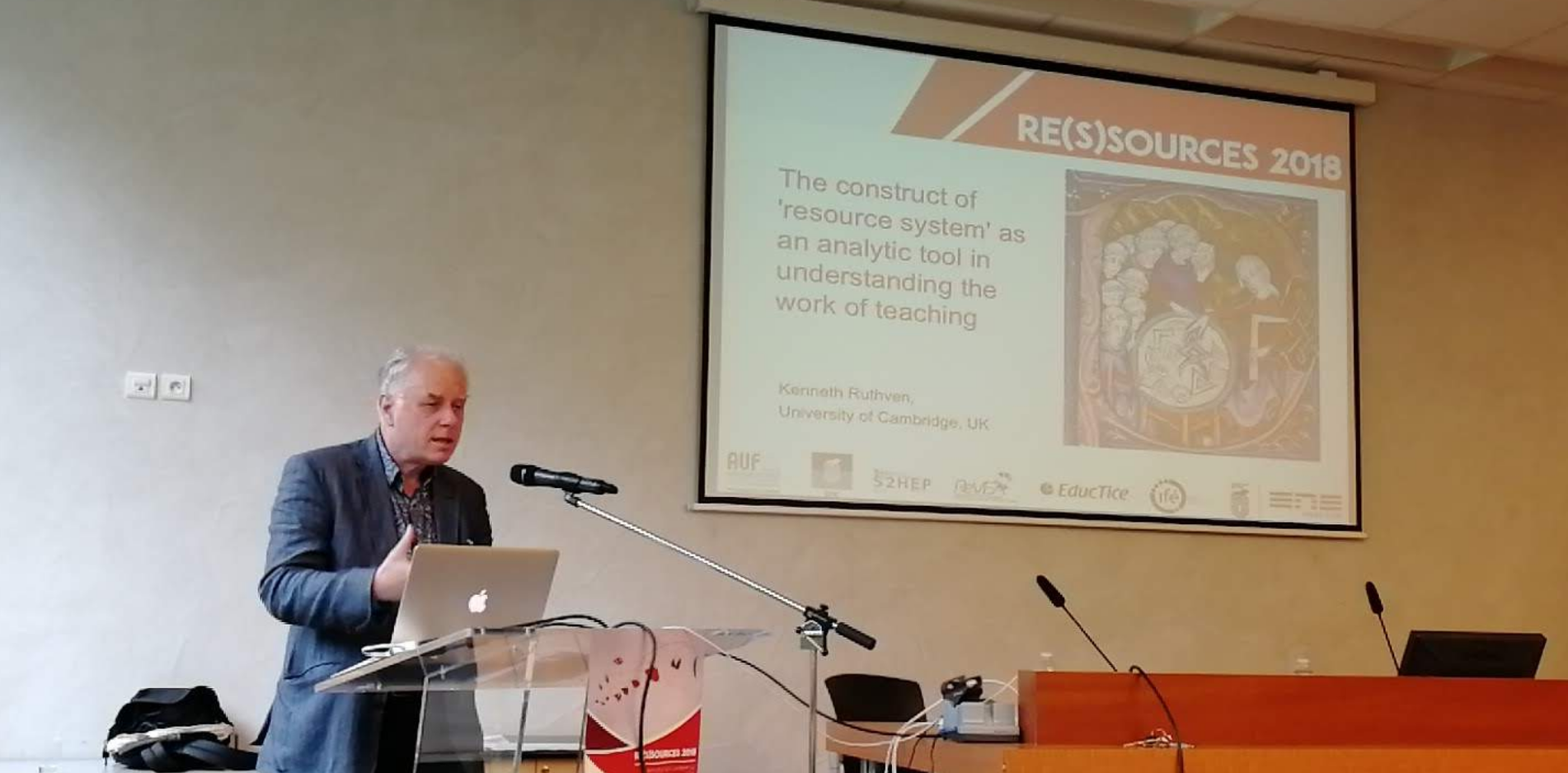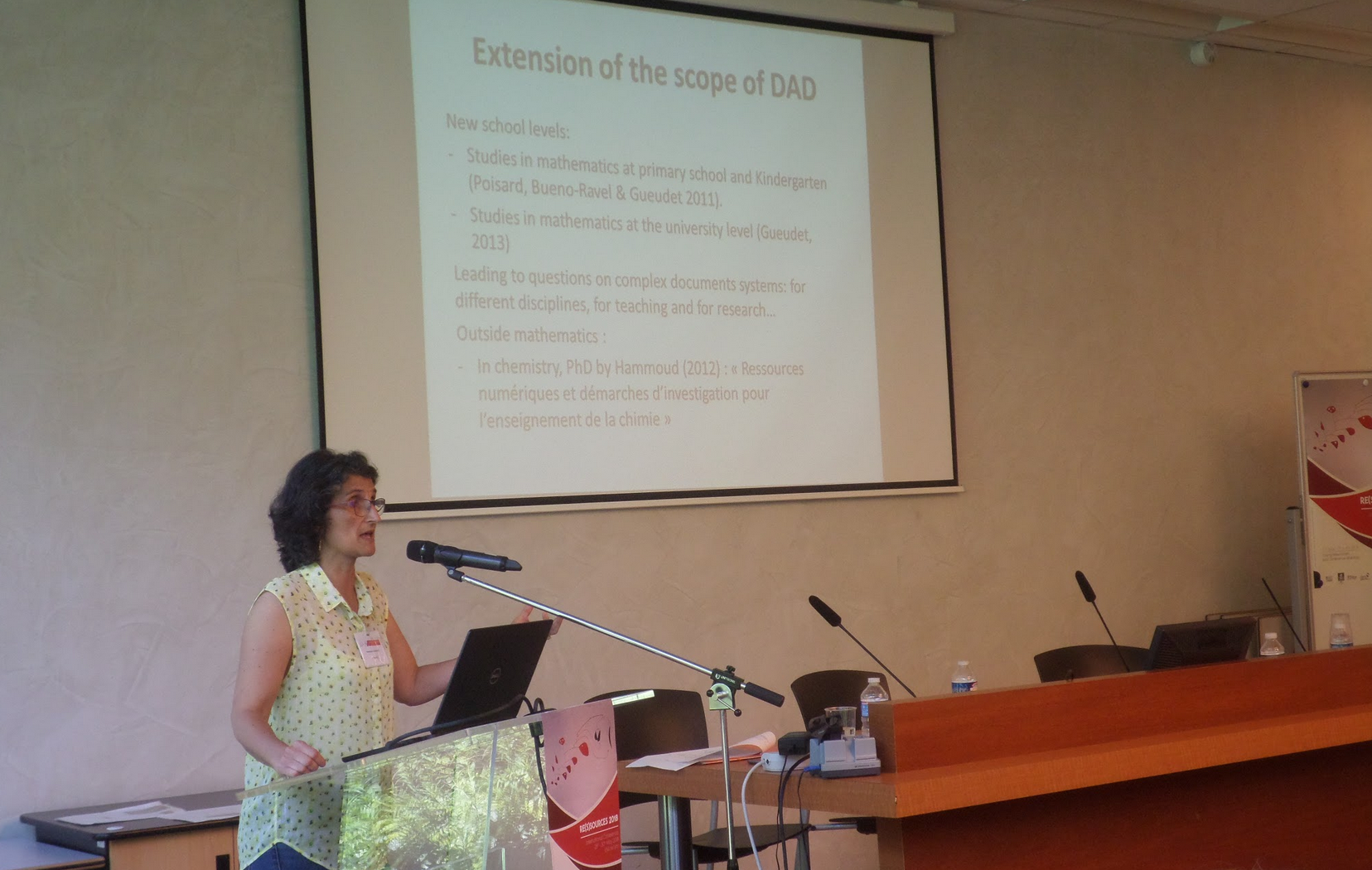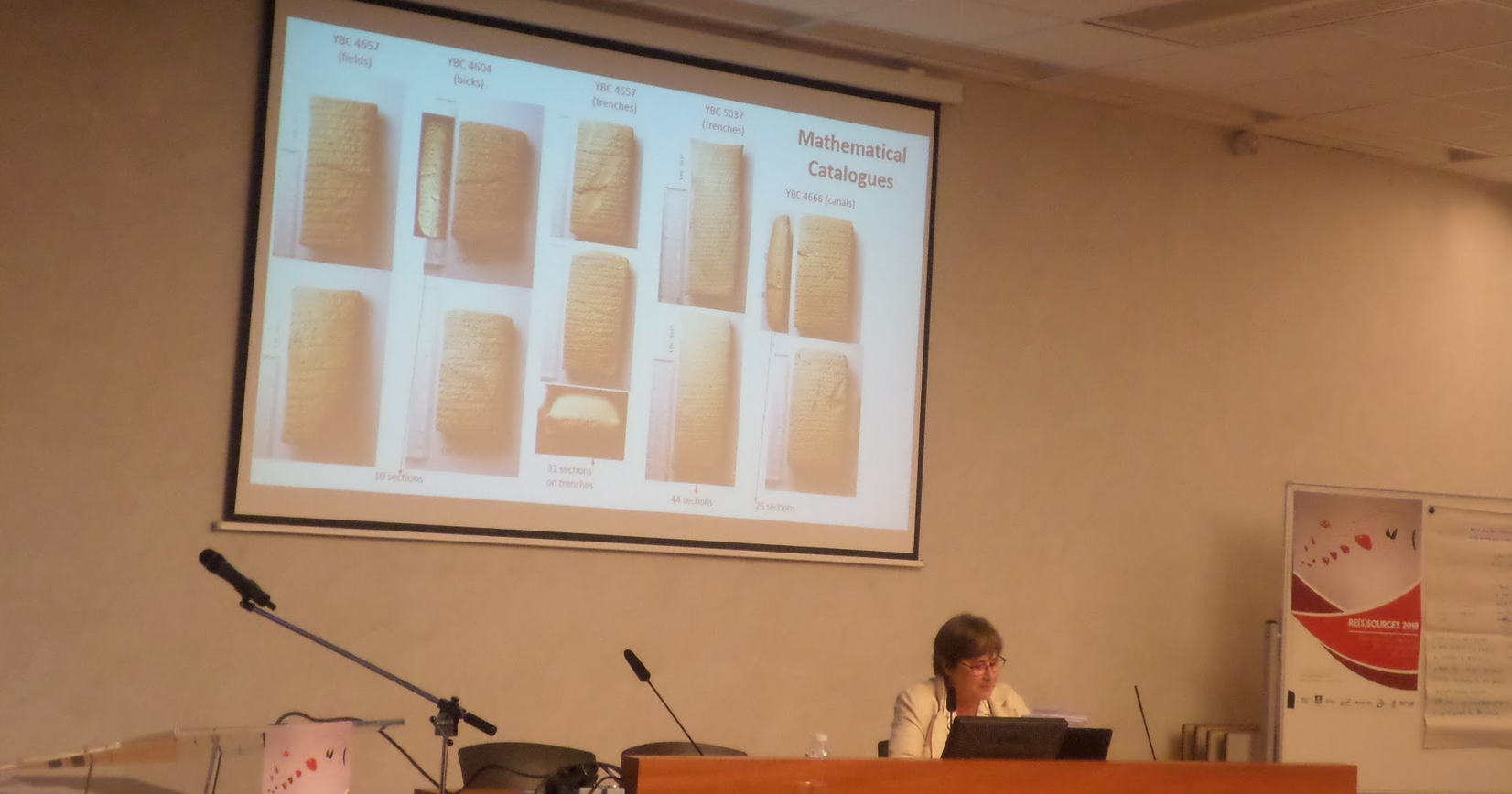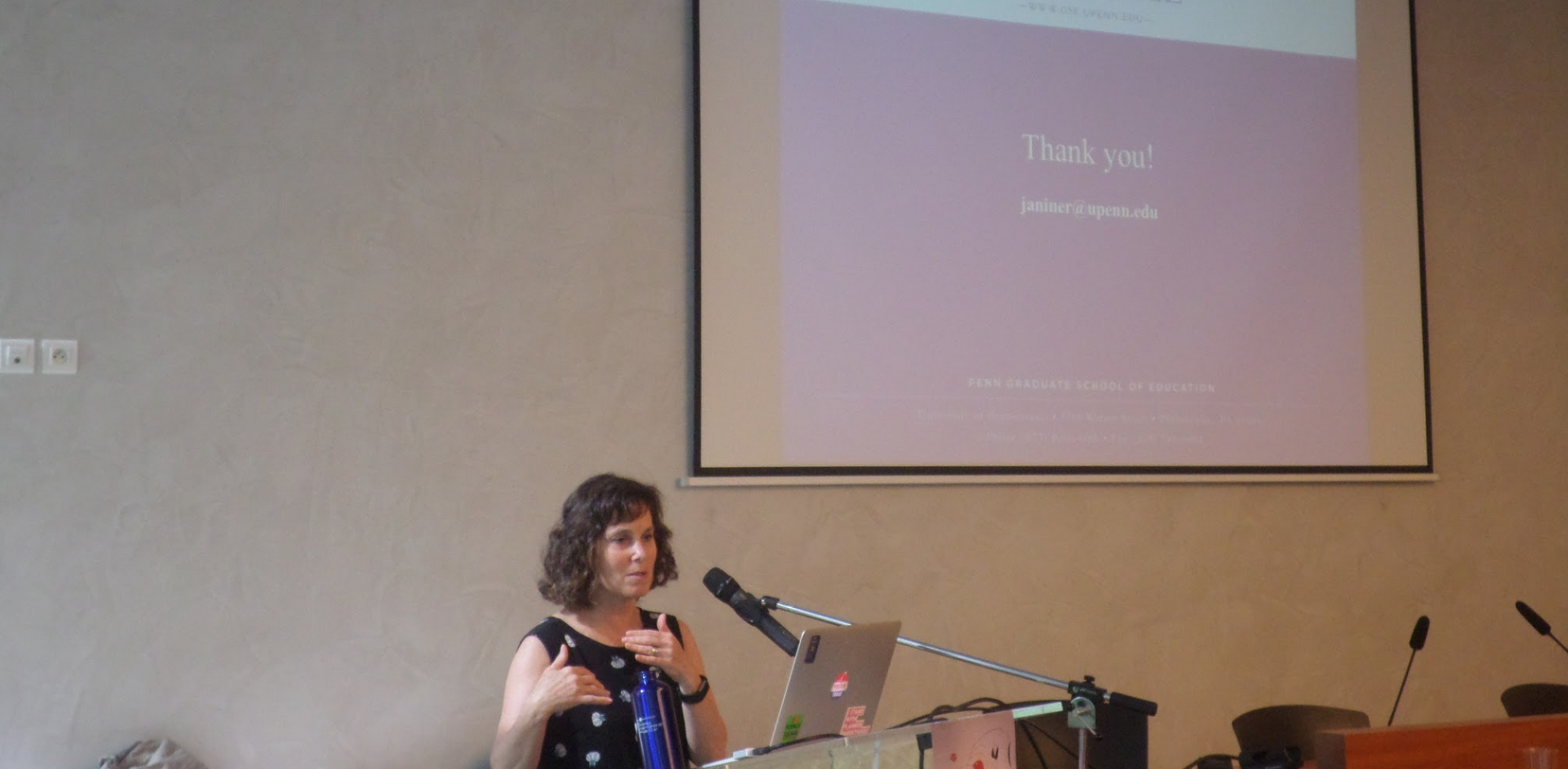Plenary lecturesPlenary lectures
The Re(s)sources 2018 conference proposed 7 lectures, which will give rise to chapters in the book published in December 2019 in the Springer series Advances in Mathematics Education. Kenneth Ruthven (University of Cambridge, UK): The construct of 'resource system' as an analytic tool in understanding the work of teaching (video) (slides to be downloaded)
Euclid's ingenious organization of mathematical material from different sources to form the Elements created a systematic text which served as a base for the study and teaching of mathematics for more than two millennia. To this day, the idea of creating a coherent system of resources following some concerted approach continues to inform the design of textbooks and curriculum schemes. However, when teachers are encouraged to draw on multiple sources to enrich their teaching, they face the challenge not only of comprehending, but often of reconciling, contrasting approaches, so as to create their own system of resources. In an era of flexible curriculum schemes, of reusable learning objects, and of proliferating mediating technologies, this challenge becomes all the greater. This lecture will examine how this aspect of the work of teaching has been analyzed in recent research, notably the lines of investigation initiated by Ruthven (2009 et seq.) and Gueudet & Trouche (2009 et seq.). Fan, L., Zhu, Y., & Miao, Z. (2013). Textbook research in mathematics education: development status and directions. ZDM, 45(5), 633-646. Gueudet, G., & Trouche, L. (2009). Towards new documentation systems for mathematics teachers? Educational Studies in Mathematics, 71(3), 199-218. Heath, T. L. (1908). The thirteen books of Euclid's Elements. Cambridge: Cambridge University Press. Ruthven, K. (2009). Towards a naturalistic conceptualisation of technology integration in classroom practice: The example of school mathematics. Éducation et didactique, 3(1), 131-159. Ghislaine Gueudet (University of Western Brittany, France) Studying Teachers’ documentation work: emergence of a theoretical approach (video) (slides to be downloaded)
The documentational approach to didactics is a recent theory –less than ten years old. In this conference I will look back at the process of development of this approach. I will recall the initial context, motivating the elaboration of a specific frame for studying teachers’ documentation work. Several kinds of evolutions will be emphasized: theoretical, methodological, but also evolutions of the questions studied in the research works referring to the documentational approach. I will conclude by evidencing the perspectives for future research and further evolutions. Adler, J. (2000). Conceptualising resources as a theme for teacher education, Journal of Mathematics Teacher Education, 3, 205–224. Guin D., Ruthven K., & Trouche, L. (Eds.). (2005). The didactical challenge of symbolic calculators: turning a computational device into a mathematical instrument. New York: Springer. Gueudet, G., Pepin, B., & Trouche, L. (Eds.). (2012). From text to ‘lived’ resources: Mathematics curriculum materials and teacher development. New York: Springer. Gueudet, G., Pepin, B., & Trouche, L. (2013). Collective work with resources: an essential dimension for teacher documentation. ZDM, The International Journal on Mathematics Education, 45(7), 1003-1016. Gueudet, G., Trouche, L. (2009). Towards new documentation systems for mathematics teachers? Educational Studies in Mathematics 71, 199-218. Pédauque, R. T. (coll.) (2006). Le document à la lumière du numérique. Caen : C & F éditions. Rabardel, P. (2002/1995). People and technology, a cognitive approach to comtemporary instruments /Les hommes et les technologies: Approche cognitive des instruments contemporains. Paris: Armand Colin, Retreived on http://ergoserv.psy.univ-paris8.fr/Site/default.asp?Act_group=1 Remillard, J.T. (2005). Examining key concepts in research on teachers' use of mathematics curricula. Review of Educational Research, 75(2), 211-246. Ruthven, K. (2007). Teachers, technologies and the structures of schooling. In D. Pitta-Pantazi & G. Philippou (Eds.), Proceedings of the Fifth Congress of the European Society for Research in Mathematics Education (pp. 52-67). Larnaca: CERME-5. Trouche, L. (2004). Managing complexity of human/machine interactions in computerized learning environments: Guiding students' command process through instrumental orchestrations. International Journal of Computers for Mathematical Learning, 9, 281-307. Christine Proust: (CNRS, Paris): How did mathematics teachers work four thousand years ago? Curricula and syllabuses in Mesopotamia (video) (slides to be downloaded)
Surprising as it may seem, education in Mesopotamia is remarkably well documented. The reason for this abundance of sources is the nature of the writing support that was used in the Ancient Near East, namely, the clay, an indestructible material that has survived from antiquity to the present day. School exercises, including mathematics exercises, have been found by the tens of thousands during archaeological excavation in Iraq, Syria and Iran. One can detect how masters worked through careful analysis of exercises for beginners and sets of problems for advanced students. The work of masters left traces on these documents, which allow us to partly reconstruct the organization of teaching. In this paper, I focus on didactical structures conveyed by sets of texts from diverse levels of education. I show the diversity of these structures, and try to grasp the mathematical notions conveyed by them. For that, I rely on homogeneous sets of documents produced by communities of students or masters quite well identified. I consider two sets of texts from Nippur, and a set of texts found in a Southern city, perhaps Larsa. Michalowski, P. (2012). Literacy, Schooling and the Transmission of Knowledge in Early Mesopotamian Culture. In W. S. van Egmond & W. H. van Soldt (Eds.), Theory and Practice of Knowledge Transfer. Studies in School Education in the Ancient Near East and Beyond (pp. 39-57). Leiden: PIHANS Proust, C. (2012). Teachers' writings and students' writings: school material in Mesopotamia. In G. Gueudet, B. Pepin & L. Trouche (Eds.), From Text to 'Lived' Resources: Mathematics curriculum materials and teacher development (pp. 161-179). New York: Springer. Proust, C. (2014). Does a Master always Write for his Students? Some Evidence from Old Babylonian Scribal Schools. In A. Bernard and C. Proust (Eds.), Scientific Sources and Teaching Contexts throughout History: Problems and Perspectives (Boston Studies in the Philosophy of Science) (pp. 69-94). New York: Springer. Proust, C. (2015 (issued 2017)). La chanson des mathématiques dans l’Edubba. In M. C. Bustamante (Ed.), Scientific Writings and Orality (Archives Internationales d’Histoire des Sciences Vol. 65/2) (pp. 19-49). Brepols, Veldhuis, N. (1997). Elementary Education at Nippur, The Lists of Trees and Wooden Objects, Ph. D. dissertation, University of Groningen. Michèle Artigue (LDAR, Université Paris Diderot-Paris 7): Reflecting on a theoretical approach from a networking perspective: the case of the documentational approach to didactics (video) (slides to be downloaded) One decade ago, the documentational approach to didactics (Gueudet, Pepin, & Trouche, 2012) was just emerging. Since then, it has developed and matured, benefitting from the collaborative work and contributions of researchers with different research background and educational culture. It has also extended its scope beyond the sole field of mathematics education. The diversity of those who have contributed to the development of this approach has expressed through a diversity of theoretical constructions and combinations. In this lecture, I will reflect on this development from a networking perspective. More precisely, relying on the vision of networking as a research practice at stake in (Bikner-Ahsbahs & Prediger, 2014) and the concept of ‘research praxeology’ introduced in (Artigue, Bosch & Gascón, 2011), I will study the influence of this diversity on the research praxeologies developed by the researchers working in that area, the interactions between these praxeologies, and the outcomes of this research. Artigue M., Bosch, M., & Gascón J. (2011). Research praxeologies and networking theories. In, M. Pytlak, T. Rowlad, & E. Swoboda (Eds), Proceedings of the Seventh Congress of the European Society for Research in Mathematics Education (pp. 281-2390). Poland: University of Rzeszów. Bikner-Ahsbahs, A., & Prediger, S. (Eds.) (2014). Networking of Theories as a Research Practice in Mathematics Education. New York: Springer. Gueudet, G., Pepin, B., & Trouche, L. (Eds.). (2012). From text to ‘lived’ resources: Mathematics curriculum materials and teacher development. New York: Springer Janine Remillard (Graduate School of Education, University of Pennsylvania): Teachers’ Use of Mathematics Resources: A Look across Cultural Boundaries (video) (slides to be downloaded)
Curriculum resources are adopted in school systems around the world, often, to promote curricular coherence or reform (Pepin & Haggarty, 2001; Valverde et al., 2012). The development and design of these resources varies across systems, as do the expectations for and assumptions about their use (Remillard, Van Steenbrugge, & Bergqvist 2016). Ultimately, teachers’ interpretations and decisions are at the center of resource use. In this lecture, I present initial findings from a cross-cultural study of elementary teachers’ interpretations and use of mathematics curriculum resources in four cultural contexts, Sweden, Belgium (Flanders), Finland, and the United States. We consider differences in how curriculum resources are made available to teachers, and how teachers make use of them to shape instruction. We also examine the extent to which teachers make use of additional resources, particularly those available through the global marketplace on the Internet. Pepin, B., & Haggarty, L. (2001). Mathematics textbooks and their use in English, French, and German classrooms: a way to understand teaching and learning cultures. The International Journal on Mathematics Education (ZDM), 33(5), 158-175. Valverde, G. A., Bianchi, L. J., Wolfe, R. G., Schmidt, W. H., & Houang, R. T. (2002). According to the book: Using TIMSS to investigate the translation of policy into practice through the world of textbooks. Dordrecht, the Netherlands: Kluwer. Remillard, J. T., Van Steenbrugge, H., & Bergqvist, T. (2016). A cross-cultural analysis of the voice of six teacher's guides from three cultural contexts. Paper presented at the AERA annual meeting, Washington, DC. Takeshi Miyakawa (Joetsu University of Education) & Binyan Xu ((East China Normal University, Shanghai): Teachers collective work inside and outside school as an essential spring of mathematics teachers' documentation: Japanese and Chinese experiences (video) (slides to be downloaded) As opposed to the individualistic perspective that has seemed dominant in teacher’s work for teaching the lesson, one may find today a wide range of teachers’ collective works inside and outside school in different parts of the world, such as collective improvement of teaching practice in Japanese Lesson Study (Fernandez & Yoshida, 2004) and Chinese Teaching Research Group, and collective writing of mathematics textbooks in France (Sésamath series). In this lecture, we try to show how teachers’ collective work promotes documentational works on the resources including teaching material, lesson plan, textbooks, etc. for developing, communicating, sharing, and disseminating teaching practice and knowledge, through two East Asian examples which are comparative and complementary each other: the activities of mathematics teachers’ local circle outside school in Japan (Miyakawa & Winsløw, to appear) on the one hand, and Teaching Research Group inside school in China (Wang, 2011; Gu & Wang, 2003) on the other hand. Gu, L.Y. & Wang, J. (2003). Teachers’ Professional Development in Action Education. Curriculum-Textbook-Pedagogy, 1(2), 2-10. Fernandez, C. & Yoshida, M. (2004). Lesson study – a Japanese approach to improving mathematics teaching and learning. Mahwah: Lawrence Erlbaum. Miyakawa, T. & Winsløw, C. (to appear). Paradidactic infrastructure for sharing and documenting mathematics teacher knowledge: a case study of “practice research” in Japan. Wang, J.P. (2012). Mathematics Education in China: Tradition and Reality. Singapore: Cengage Learning Asia Pte Ltd.
Luc Trouche (French Institute of Education, Ecole normale supérieure de Lyon, France): Evidencing the missing resources of the documentational approach to didactics, towards new programs of research (video) (slides to be downloaded) The development of a theoretical approach creates necessarily new needs, conceptual as well as methodological: when meeting new phenomena; when extending the study outside its initial field (in this case mathematics teaching in French secondary schools); when meeting other theoretical frames. Evidencing its missing resources (Chevallard & Cirade, 2010) is then a critical issue for a community of research. We will propose to face this issue, developing a reflective investigation in two directions: asking the recent Ph.D. students having situated their research into the DAD; examining the questions of denomination (Rousseau & Morvan, 2000) arising from crossing linguistic, curricular and cultural borders (Libbrecht et al., 2008; Pepin et al., 2013), particularly in the Chinese case (Pepin et al., 2016). We will draw from this investigation some programs of research for supporting the development of the documentational approach to didactics. Chevallard, Y., & Cirade, G. (2010). Les ressources manquantes comme problème professionnel. In G. Gueudet, & L. Trouche, L. (dir.), Ressources vives. Le travail documentaire des professeurs en mathématiques (pp. 41-55). Rennes: PUR. Libbrecht, P., Desmoulins, C., Mercat, C., Laborde, C., Dietrich, M., & Hendriks, M. (2008). Cross-Curriculum Search for Intergeo. Lecture notes in computer science 5144/2008, 520-535 Pepin, B., Gueudet, G., & Trouche, L. (2013). Investigating textbooks as crucial interfaces between culture, policy and teacher curricular practice: two contrasted case studies in France and Norway, ZDM, The International Journal on Mathematics Education, 45(5), 685-698 Pepin, B., Xu, B., Trouche, L., & Wang, C. (2016). Developing a deeper understanding of mathematics teaching expertise: Chinese mathematics teachers’ resource systems as windows into their work and expertise. Educational studies in Mathematics, 94(3), 257–274, http://rdcu.be/koXk. Rousseau, D., & Morvan, M. (2000). La dénomination. Le temps des savoirs, 1. Paris : Odile Jacob |







